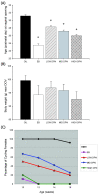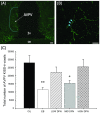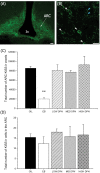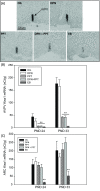Influence of ERβ selective agonism during the neonatal period on the sexual differentiation of the rat hypothalamic-pituitary-gonadal (HPG) axis
- PMID: 22260364
- PMCID: PMC3292502
- DOI: 10.1186/2042-6410-3-2
Influence of ERβ selective agonism during the neonatal period on the sexual differentiation of the rat hypothalamic-pituitary-gonadal (HPG) axis
Abstract
Background: It is well established that sexual differentiation of the rodent hypothalamic-pituitary-gonadal (HPG) axis is principally orchestrated by estrogen during the perinatal period. Here we sought to better characterize the mechanistic role the beta form of the estrogen receptor (ERβ) plays in this process.
Methods: To achieve this, we exposed neonatal female rats to three doses (0.5, 1 and 2 mg/kg) of the ERβ selective agonist diarylpropionitrile (DPN) using estradiol benzoate (EB) as a positive control. Measures included day of vaginal opening, estrous cycle quality, GnRH and Fos co-localization following ovariectomy and hormone priming, circulating luteinizing hormone (LH) levels and quantification of hypothalamic kisspeptin immunoreactivity. A second set of females was then neonatally exposed to DPN, the ERα agonist propyl-pyrazole-triol (PPT), DPN+PPT, or EB to compare the impact of ERα and ERβ selective agonism on kisspeptin gene expression in pre- and post-pubescent females.
Results: All three DPN doses significantly advanced the day of vaginal opening and induced premature anestrus. GnRH and Fos co-labeling, a marker of GnRH activation, following ovariectomy and hormone priming was reduced by approximately half at all doses; the magnitude of which was not as large as with EB or what we have previously observed with the ERα agonist PPT. LH levels were also correspondingly lower, compared to control females. No impact of DPN was observed on the density of kisspeptin immunoreactive (-ir) fibers or cell bodies in the arcuate (ARC) nucleus, and kisspeptin-ir was only significantly reduced by the middle (1 mg/kg) DPN dose in the preoptic region. The second experiment revealed that EB, PPT and the combination of DPN+PPT significantly abrogated preoptic Kiss1 expression at both ages but ARC expression was only reduced by EB.
Conclusion: Our results indicate that selective agonism of ERβ is not sufficient to completely achieve male-typical HPG organization observed with EB or an ERα agonist.
Figures





Similar articles
-
Biological role of pituitary estrogen receptors ERalpha and ERbeta on progesterone receptor expression and action and on gonadotropin and prolactin secretion in the rat.Neuroendocrinology. 2004;79(5):247-58. doi: 10.1159/000079100. Epub 2004 Jun 15. Neuroendocrinology. 2004. PMID: 15205556
-
Disrupted female reproductive physiology following neonatal exposure to phytoestrogens or estrogen specific ligands is associated with decreased GnRH activation and kisspeptin fiber density in the hypothalamus.Neurotoxicology. 2008 Nov;29(6):988-97. doi: 10.1016/j.neuro.2008.06.008. Epub 2008 Jul 6. Neurotoxicology. 2008. PMID: 18656497 Free PMC article.
-
Neonatal imprinting and regulation of estrogen receptor alpha and beta mRNA expression by estrogen in the pituitary and hypothalamus of the male rat.Neuroendocrinology. 2001 Jan;73(1):12-25. doi: 10.1159/000054616. Neuroendocrinology. 2001. PMID: 11174013
-
ERalpha, but not ERbeta, mediates the expression of sexual behavior in the female rat.Behav Brain Res. 2008 Aug 5;191(1):111-7. doi: 10.1016/j.bbr.2008.03.016. Epub 2008 Mar 21. Behav Brain Res. 2008. PMID: 18433893
-
Long-Term Neonatal Estrogen Exposure Causes Irreversible Inhibition of LH Pulses by Suppressing Arcuate Kisspeptin Expression via Estrogen Receptors α and β in Female Rodents.Endocrinology. 2017 Sep 1;158(9):2918-2929. doi: 10.1210/en.2016-1144. Endocrinology. 2017. PMID: 28368450
Cited by
-
The development of kisspeptin circuits in the Mammalian brain.Adv Exp Med Biol. 2013;784:221-52. doi: 10.1007/978-1-4614-6199-9_11. Adv Exp Med Biol. 2013. PMID: 23550009 Free PMC article. Review.
-
Development and Aging of the Kisspeptin-GPR54 System in the Mammalian Brain: What are the Impacts on Female Reproductive Function?Front Endocrinol (Lausanne). 2013 Mar 28;4:22. doi: 10.3389/fendo.2013.00022. eCollection 2013. Front Endocrinol (Lausanne). 2013. PMID: 23543285 Free PMC article.
-
Effects of perinatal bisphenol A exposure on the volume of sexually-dimorphic nuclei of juvenile rats: A CLARITY-BPA consortium study.Neurotoxicology. 2017 Dec;63:33-42. doi: 10.1016/j.neuro.2017.09.002. Epub 2017 Sep 7. Neurotoxicology. 2017. PMID: 28890130 Free PMC article.
-
Kisspeptin prevention of amyloid-β peptide neurotoxicity in vitro.ACS Chem Neurosci. 2012 Sep 19;3(9):706-19. doi: 10.1021/cn300045d. Epub 2012 May 30. ACS Chem Neurosci. 2012. PMID: 23019497 Free PMC article.
-
Organizational and activational effects of sex steroids on kisspeptin neuron development.Front Neuroendocrinol. 2013 Jan;34(1):3-17. doi: 10.1016/j.yfrne.2012.06.001. Epub 2012 Jun 19. Front Neuroendocrinol. 2013. PMID: 22728025 Free PMC article. Review.
References
-
- Gorski RA, Mennin SP, Kubo K. The neural and hormonal bases of the reproductive cycle of the rat. Adv Exp Med Biol. 1975;54:115–153. - PubMed
-
- Bateman HL, Patisaul HB. Disrupted female reproductive physiology following neonatal exposure to phytoestrogens or estrogen specific ligands is associated with decreased GnRH activation and kisspeptin fiber density in the hypothalamus. Neurotoxicology. 2008;29:988–997. doi: 10.1016/j.neuro.2008.06.008. - DOI - PMC - PubMed
Grants and funding
LinkOut - more resources
Full Text Sources

